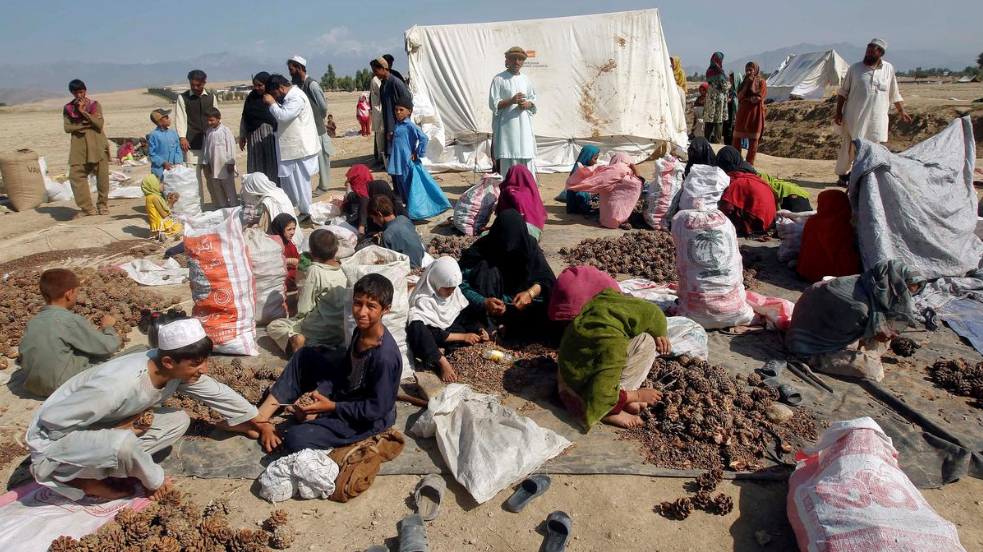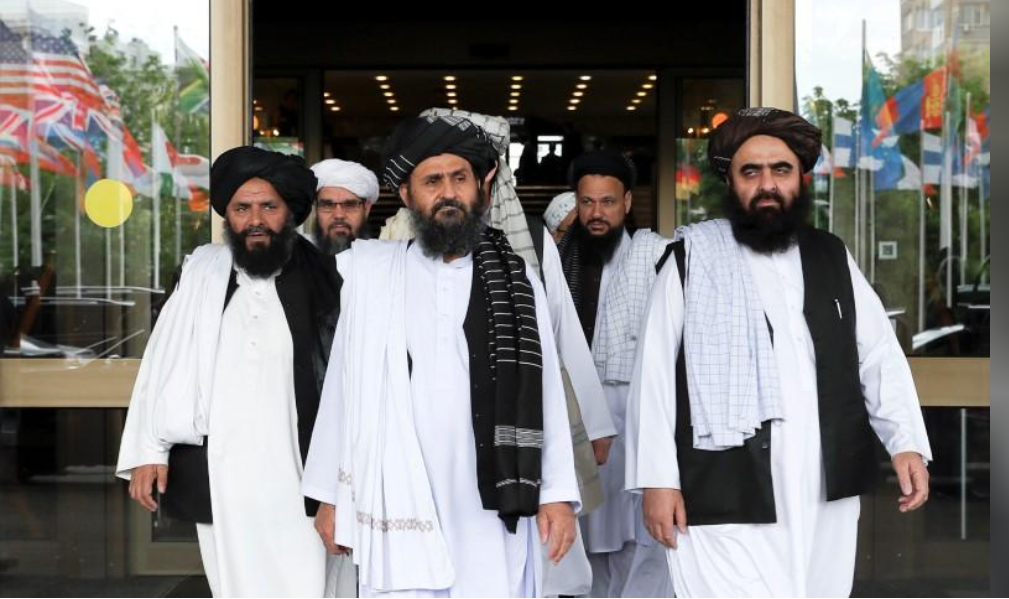
Afghans work on a pine nuts field in Jalalabad province, Afghanistan, October 10, 2012. /Reuters Photo
Afghans work on a pine nuts field in Jalalabad province, Afghanistan, October 10, 2012. /Reuters Photo
Afghanistan has been rocked by a prolonged war for more than 18 years. The warring parties are currently mired in a perennial stalemate with both sides failing to make sustainable territorial gains.
With U.S. anti-war sentiment on the rise and deals-seeking Trump at the helm of the White House, an unprecedented initiative to start direct talks with the Taliban in the hope of securing a peace deal was launched in September 2018.
The talks have now hit 11 rounds but the process has been on-and-off due to intensifying violence for which the Taliban is largely responsible. Washington's latest re-engagement with the Taliban only started in December, a month after Trump decided to pump the breaks for a moment because of Taliban attacks on U.S. assets in Afghanistan.
Although the protracted negotiations have yet to produce tangible results, a glimmer of hope has resurfaced when U.S. Secretary of Defense Mark Esper on Saturday confirmed that the U.S. has reached a "reduction in violence" agreement with the Taliban. The deal is slated to take place in a period of seven days and will ultimately bring about a cut in the number of U.S. troops from around 12,000 down to 8,600.
On top of that, a broader agreement addressing some other U.S. top interests is also expected to be signed following the nationwide pause in violence. While optimism for the completion of an eventual peace agreement runs high, it still leaves a slew of questions regarding the future of Afghanistan unanswered.
U.S. deliberations
Speculations that Trump does not have in mind the best interests of Afghans have been circulating among observers throughout the entire peace process. The arguments to support this assertion run so deep that Western media have even dubbed Trump's efforts as a "peace rush."

U.S. President Donald Trump delivers remarks in an unannounced visit to Bagram Air Base, Afghanistan, November 28, 2019. /Reuters Photo
U.S. President Donald Trump delivers remarks in an unannounced visit to Bagram Air Base, Afghanistan, November 28, 2019. /Reuters Photo
According to commentators, Trump's approach to Afghanistan has the hallmark of his general approach to foreign policy, of which the most conspicuous is an inserted America-first connotation.
The political motive underlying Trump's pledge to hammer out a deal with the Taliban rests largely on his resolve to bring all U.S. troops home. "Trump believes that the U.S. cannot defeat the Taliban and it is useless to risk soldiers' lives and waste money," said Meir Litvak, chair of the Department of Middle Eastern and African History at Tel Aviv University, in an interview with CGTN.
This is also one of the main reasons why the reduction of violence deal can come into fruition despite the fact that the Taliban-proposed deal was initially dismissed by Afghan officials due to the ambiguities of the language, Litvak continued. Once the deal is exercised properly, they can both carry on where they left off in September.
A comprehensive peace deal between the Taliban and the U.S. will be "very similar to the one the U.S. has signed with Vietnam in 1972, as Trump is looking for an honorable way out," Litvak added.
Taliban calculations
Although the White House has publicly claimed that extracting from the deal a Taliban compliance to sit down with Afghan leaders is also one of their main objectives, U.S. officials don't seem to have a feasible plan to facilitate the materialization of an actual sit-down between the Taliban and Afghan authorities, as the Taliban have long refused to engage directly with the current administration and have not changed its position.

Members of a Taliban delegation leaving after peace talks with Afghan senior politicians in Moscow, Russia, May 30, 2019. /Reuters Photo
Members of a Taliban delegation leaving after peace talks with Afghan senior politicians in Moscow, Russia, May 30, 2019. /Reuters Photo
"It is very important for the people of Afghanistan that the U.S. should not agree with the Taliban without having the Afghan government involved in the process," Lailuma Nasiri, co-founder and president of Afghanistan Justice Organization, commented in an interview with CGTN.
But ensuring the inclusion of the Afghan government in the peace talks does not seem to be among the list of U.S. priorities, as indicated by Shaharzad Akbar, a prominent Afghan activist and a participant of intra-Afghan dialogue held in Doha last year, in her opinion piece published on CNN.
She remarked in the article that when she sought assurances from U.S. Representative Zalmay Khalilzad to not compromise on "Afghanistan's hard-won human rights and freedoms" on the sidelines of the Doha meeting, Khalilzad only gave a "vague" and "well-rehearsed" response, claiming Afghanistan's future will be "for Afghans, and Afghans alone, to decide."
What is also complicating the peace process are the rough realities on the ground. Although the militant group claimed on several occasions that they would cease actively targeting civilians, its unrelenting violent attacks have persisted and the result is a spike in violence that reached a record level last year.
The discrepancy shown by its willingness to deescalate on the one hand and its tenacity in launching assaults on the other poses serious questions as to whether the armed outfit is genuinely prepared for peace in Afghanistan.
"I believe the Taliban operate in two complementing moves: Continue the military pressure to reduce American motivation to stay and further weaken the Afghan government while talking to the U.S.," Litvak remarked in his interview. "They probably believe that once the U.S. leaves, they will be able to defeat the government completely."
Another central roadblock to the achievement of overall peace in Afghanistan is the stagnant development of intra-Afghan dialogue, a peace process parallel to U.S.-Taliban talks.
Intra-Afghan dialogue
In July last year a board delegation of representatives from Afghanistan's civil society and Afghan government officials appearing in "personal capacities" partook in an intra-Afghan dialogue session with Taliban representatives.
Although the event itself was unprecedented and its diverse and all-encompassing composition was greeted with commendation and recognition of progress by world leaders, many of those who sat across from Taliban representatives were unsatisfied with the results as their concerns over a wide range of issues, chief among them the style of governance, women's rights and freedom of speech, were not seriously addressed by Taliban delegates.
As participants claimed, Taliban representatives did not show sincere willingness to engage in a meaningful debate. This palpable quandary is particularly emblematic of the ideological divide between the Taliban and the majority of Afghans. But as an Afghan activist championing for justice in Afghanistan, Nasiri offered some constructive insights.
"While Afghans do not want to go back in the dark history of the Taliban era, coexistence is not impossible," she added. "The short term ceasefire practiced a year or two back proved that majority of Taliban fighters are tired of war and ready to turn to normal peaceful life."
"It's about the opportunity to be given to practice coexistence and what is more important is the post-peace situation and how the Afghan government and its international partners would manage it, keeping in mind that we will not practice a 100% peace due to presence of ISIL plus tens of other terrorist groups operating in Afghanistan."